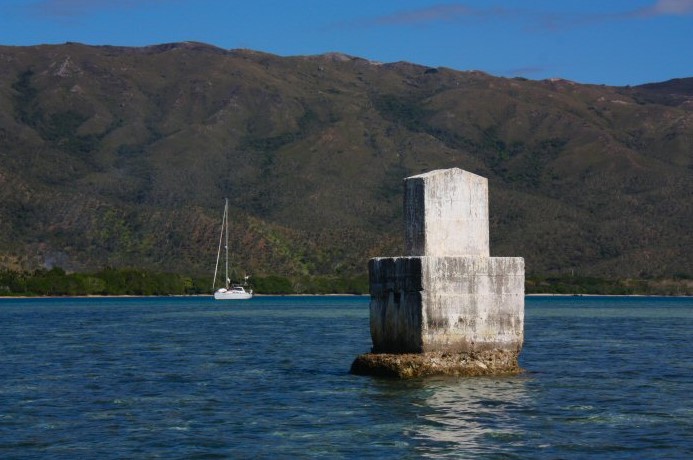In the south of Noumea, a stele is paying a tribute to the Entrecasteaux expedition, which went in search of the Lapérouse expedition between 1792 and 1793. It was erected in 1993 at the top of the small hill which extends the Pierre Vernier promenade and overlooks the nautical center of The South Province.
One can read that during this trip, Captain Jean Michel Huon de Kermadec, captain of “La Recherche“, died of exhaustion on May 6, 1793 and was buried on Poudioué islet off Balade.
This islet, located some 300 miles away, in the north of the mainland, is not far from the shore of Mahamate beach, in the town of Pouebo.
Right next to it, stands a mausoleum dedicated to Captain Jean Michel Huon de Kermadec.
Totally forgotten by traditional tourist circuits and submerged most of the time, it can remain visible for the moment, thanks to low tides.
But, helped by the acceleration of the rising waters of the recent decades, the monument is doomed to inexorably disappear within the blue waters of the lagoon. So, sooner or later, the islet will be definitely set free from the “monument” it has sheltered since more than 200 years.
Because the Poudioué islet, or rather, the still emerged part, is moving… Since 1774, the destruction of the trees and the bushes which grew there and fixed it to the reef flat, has allowed the currents of high tide to corrode the sand of one side while deposits has piled up on the other side.
In 1774, the ship Resolution landed on the shores of Balade, and James Cook set up his observatory on an island which he named “Island of the observatory”, in order to study a solar eclipse there in the afternoon of September 6. In 1793, d’Entrecasteaux had the body of his friend Jean-Michel Huon de Kermadec buried there in the sand. Since then, the island has resumed its Kanak name of Poudioué.
Then, in 1846, a first stele in honor of the first Frenchman officially dead in New Caledonia was erected by the sailors of the corvette L’Héroïne.
According to a letter from Jules Garnier to the “Société de Géographie de Paris” in 1893, this stele was in fact only a pile of coral surmounted by a cross which had to be knocked down in 1847 with the desertion of the mission. This building was then considered as a danger for navigators, being able to attract them to this pitfall.
Still according to Jules Garnier, in 1857, Captain Villegeorges and Doctor Vieillard erected a small coral monument on the islet…which was torn to pieces by a cyclone…
In 1875, the commander of the Infernet erected on the islet a tombstone prepared several years earlier in a mass of masonry. This was to serve as a frame for a marble slab and to protect its inscriptions as much as possible against the weather. According to the press of the time, coconut trees were even planted around it.
This third stele, although built, had the fate of that of 1857. The pieces of the marble slab were however recovered, transported to the ground and assembled on the hill known as “the Monument of Balade” by Benoit, a Kanak mason catechist, around 1930.
In 1934, Captain Lefèvre launched a public subscription for the construction of a fourth stele, which was still to be built on the island and which was intended to be the final one.
The monument was built in 1935 and inaugurated on February 10, 1936 by the crew of the “Savorgnan de Brazza“.
The Free French Naval Forces (FFNF) affixed a plaque there in 1943.
But the construction was again destroyed by the sea during a cyclone in 1949. The bronze plates were nevertheless recovered.

Finally, in April-May 1953, the historian Bernard Brou, Julien Pennel and Father Leroy decided to build a truly lasting monument: the fifth one.
Based on the testimonies of the Kanaks who ensured that the island was moving (which an investigation confirmed), the location of the first stelae was sought.
A solid block of reinforced concrete was built at sea, embedded in the reef, taking advantage of the high equinox low tides. The building bears the bronze plaques recovered from previous constructions.
This is the monument that can still be seen today.




